This post has been sponsored by Sertodo Copper. All opinions expressed are my own.
This Paella Valenciana recipe brings together marinated chicken thighs, tender pork, and succulent shrimp, simmered in a saffron-infused broth with vibrant vegetables and seasoned rice. Perfect for food lovers seeking a bold, authentic Spanish dish, this recipe is designed for home cooks who want to recreate the warmth and flavor of traditional paella in their own kitchens.
In this post, you'll learn how marinate paella meats for maximum flavor, how to layer ingredients for rich and complex taste, and cook a one-pan dish that's ideal for summer gatherings. In addition, you'll learn how to garnish paella like a pro.
Whether you're hosting a sunny backyard meal or planning a weekend dinner with family and friends, this recipe offers the best way to enjoy a beautiful, festive dish that's both rustic and elegant. Topped with fresh herbs, scallions, and crumbled feta, this paella is as eye-catching as it is delicious, and a true celebration of bold Mediterranean flavors.
Our Paella Valenciana Recipe features a smoky and spicy mix of jalapenos and saffron coated rice, tossed with pork and chicken marinated in a mix of fresh lemon, olive oil and oregano. As beautiful as it is delicious, and featuring the authentic flavors of Spain, Paella Valenciana is a great recipe for summer get togethers beneath sun surrounded by friends and family.
I'll be preparing today's paella with some stylish help from my friends over at Sertodo Copper, whose copper-craft stretches back over a thousand years with their team of master artisans in their workshop located in Michoacan, Mexico.
Now, without further delay, let's make some paella! Read on for a complete ingredient checklist, my answer to 'what' paella Valenciana is, and a printable recipe card.
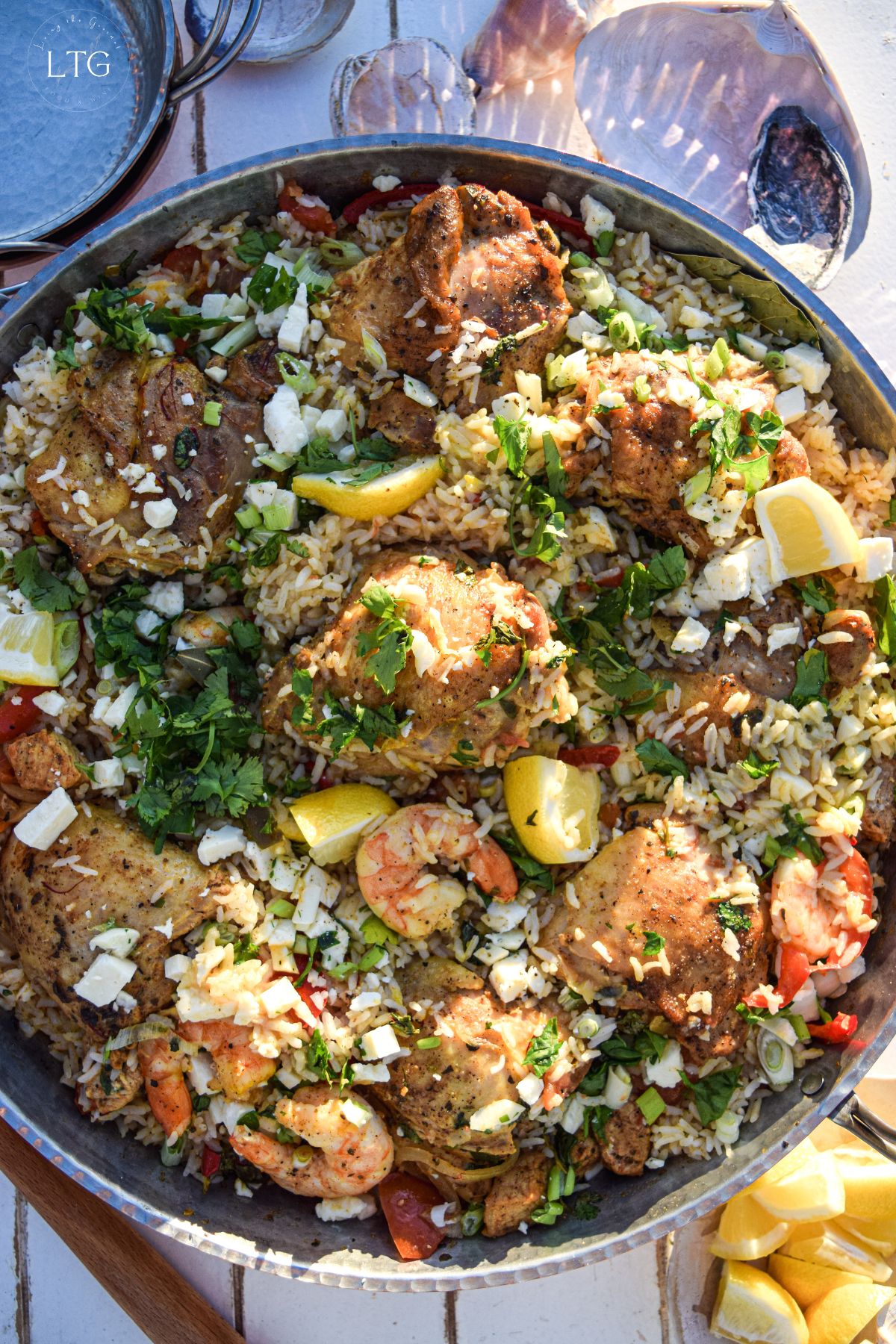
What Is Paella Valenciana? - A Famous Rice Dish
But what is Paella Valenciana? And where does this recipe originate? And do you really need a copper pan to prepare it? Also, is "paella" a dish, or a preparation method? For the answer to those questions and more, read on.
- Where is Paella Valenciana from? Spoiler: It's in the name of the dish. Paella comes from the Valencia region of Spain.
- What is Paella: For starters, any paella Valenciana recipe is basically 'just' a Spanish rice dish, but due to the recipe's celebratory flare, and mix of different ingredients, it is nevertheless far and away the most recognizable 'Spanish' recipe to non-Iberians. However, within Spain, paella is viewed as a Valencian specialty, rather than something representative of Spanish culture or being somehow a 'taste of Spain,' and certainly 'not' as a dish that symbolizes the nation or the peninsula. This would be a bit like thinking of Philly Cheesesteaks as the 'national dish' of the USA, rather than something iconic to Philadelphia. That said, paella has become so popular over the last several decades that regional and even 'non-Iberian' manifestations of the dish exist, and many of these variations are now firmly cemented in the wider culinary world - similar to how something like pizza has been embraced and molded into various non-Italian incarnations.
- A Precise Recipe or a Preparation Method? Is paella the paella mixture of ingredients, or is paella the unique, bronze-pan cooking method that melds those ingredients? In other words, can you 'paella' something in a bronze pan other than saffron, chicken thighs, seafood, and bomba rice? Is saffron, chicken thighs, seafood, and bomba rice prepared in a cast iron pan still paella? Deep questions, deep questions indeed. With that said, it is worth noting that paella in one form or another has been with us since at least the 10th century, dating back to the rice and meat casseroles of the Moors. 'Modern' paella, however, wouldn't appear until about the mid-19th century in Albufera, Valencia. Today, paella is typically thought of as a mixture of chicken, pork sausage, and shellfish tossed with saffron-yellowed rice. And yet, the most traditional version of Paella consisted of a mix of some combination of rabbit pieces, chicken (whole pieces or strips), duck, green beans, and peas tossed with plump rice prepared in olive oil seasoned with rosemary sprigs, with the rice being yellowed and flavored with saffron - although turmeric is noted as being a common substitute for saffron. A seafood variation of this paella was popular as well, which did away with meat and poultry in favor of seafood, and omitted green vegetables entirely. Notice the distinct lack of sausage, the wholly optional saffron, and the seemingly purposeful separation of seafood, poultry, and meat. As such, one can be forgiven for regarding 'paella' as a preparation method for saffron (or turmeric) yellowed rice tossed with assorted proteins. Granted, such regard may be a 'bit' of an exaggeration, but 'not' a wholly unreasonable one.
- The Saffron. While a traditional Valencian paella often substitutes saffron with turmeric, I can't help but regard the saffron flavor as 'quintessential' to the dish. Honestly, if I'm eating paella that doesn't feature the earthy and pungent notes characteristic to saffron, I can't help but feel like I'm missing out on one of the high points of the experience. As such, while it may be pricy, I say splurge for the saffron. The best paella includes saffron, and is cooked in large copper pans. Which brings us nicely to my next point.
- The Distinctive Copper Pan. For me, the presentation of the distinctive paella pan is part of the perfect paella experience, in much the same way that the ornateness of a briki and decorative demitasse cups are part of the 'experience' of Turkish coffee. However, while I love ornate cookware as much as the next gourmet, I also like my cookware to be functional. As such, I regard the combination of form and function as a key trait for pinpointing truly good products - at least in my opinion. This, I believe, is what my friends at Sertodo have really captured; the combination of beauty and utility.
- Why Use Copper? I'm using a 15-inch paella pan, made of copper. But 'why' use copper cookware? However, the big plus to using copperware is the metal's ability to rapidly conduct heat. In fact, copper is the third most heat conductive material available, behind only diamond and silver, and even then, silver only conducts heat some ten percent better than copper. But what does this ability to conduct heat mean in the kitchen? If you've ever used stainless steel, you're probably way more familiar than you'd like with 'hot spots,' those areas of the pan that are hotter than the rest, and that never seem to go away no matter how long the pan sits on the burner. This simply never happens with copper. Copperware heats up and cools 'very' rapidly, allowing for precise temperature control while ensuring an even spread of heat throughout the surface of the pan.
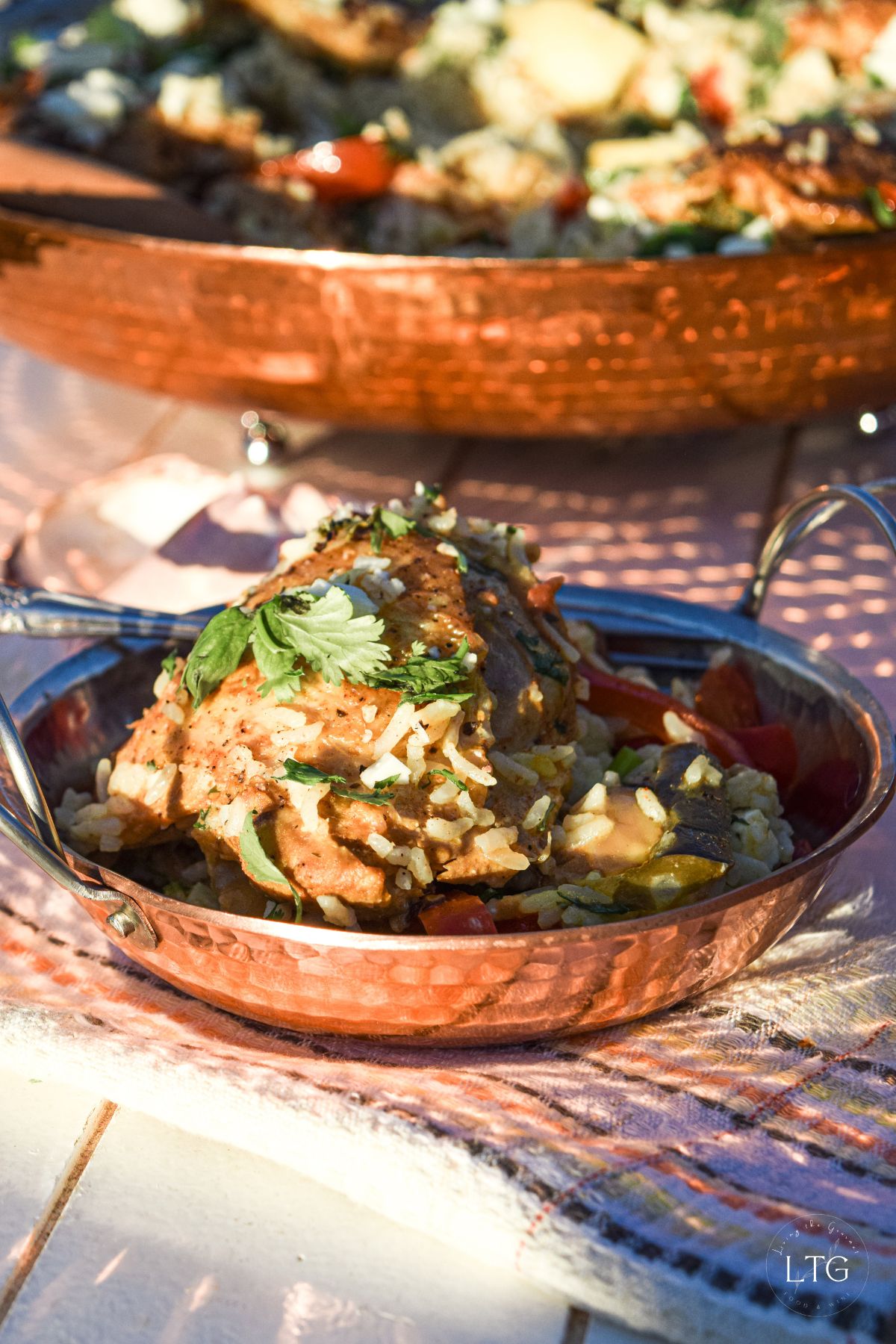
What to Expect our Paella Valenciana Recipe
- Taste and Texture
- Taste: Vibrant Spanish Flavors. A good paella should be a flavor-packed celebration of land and sea, and today's key ingredients, including chicken, shrimp, pork, and peppers, carried on saffron-flavored rice, with fresh citrus notes brought by lemon juice and herbs, with just a hint of brine from the feta, achieve exactly that.
- Texture: Juicy Succulence. The slow simmer that we use to combine the vegetables, saffron, and white wine works to create a beautifully fragrant base, while working to infuse the rice with golden yellow color and brothy richness, which delivers that classic paella heartiness. Finished with feta and a squeeze of lemon, this paella is sure to impress at your next summer get-together.
- Difficulty Level:
- Adventurous. Paella Valenciana is a great recipe for home chefs that are best described as 'adventurous.' As laid out in the recipe card, this recipe involves cooking 'three' different proteins, a medley of different vegetables, preparing saffron rice, and then tying it all together with a slow simmer. The recipe also is sensitive to the type of cookware you use, being best prepped in a copper paella pan. The secret behind this recipe is patience, patience that allows for the gradual layering of flavors, which is probably the best way to think of this recipe's prep process.
- Preparation Process
- Involved. We start things off by marinating the shrimp, chicken, and pork in a citrus-herb. I would recommend marinating them for at least an hour - or up to overnight for best results. From there, we sear the chicken and pork. We're looking for a nice golden brown color on both. After that, we begin assembling the paella with onions, garlic, tomatoes, peppers, spices and herbs. After simmering the paella with a mix of broth and wine, the shrimp and saffron are added to the pan. We add the rice towards end, folding it in with a wooden spoon, before finishing with the garnishes. I'll admit that this is a slow process, but I promise the reward at the end is worth it - but perhaps that slow process is part of the allure of a traditional dish like this one.
- Pairings
- Sides: Crusty bread, a light green salad with a citrus vinaigrette, and simple things like marinated olives and cured meat would all pair deliciously.
- Desserts: A fresh fruit, perhaps with a red wine syrup, or a decent flan, would deliciously complement this Paella Valenciana recipe, especially true if you're looking for added authenticity and just a little extra Spanish flair.
- Wine: A crisp white wine, such as an Albariño or Verdejo, or, if serving this paella out in the sun on a warm summer day, a fruit-forward rosé.
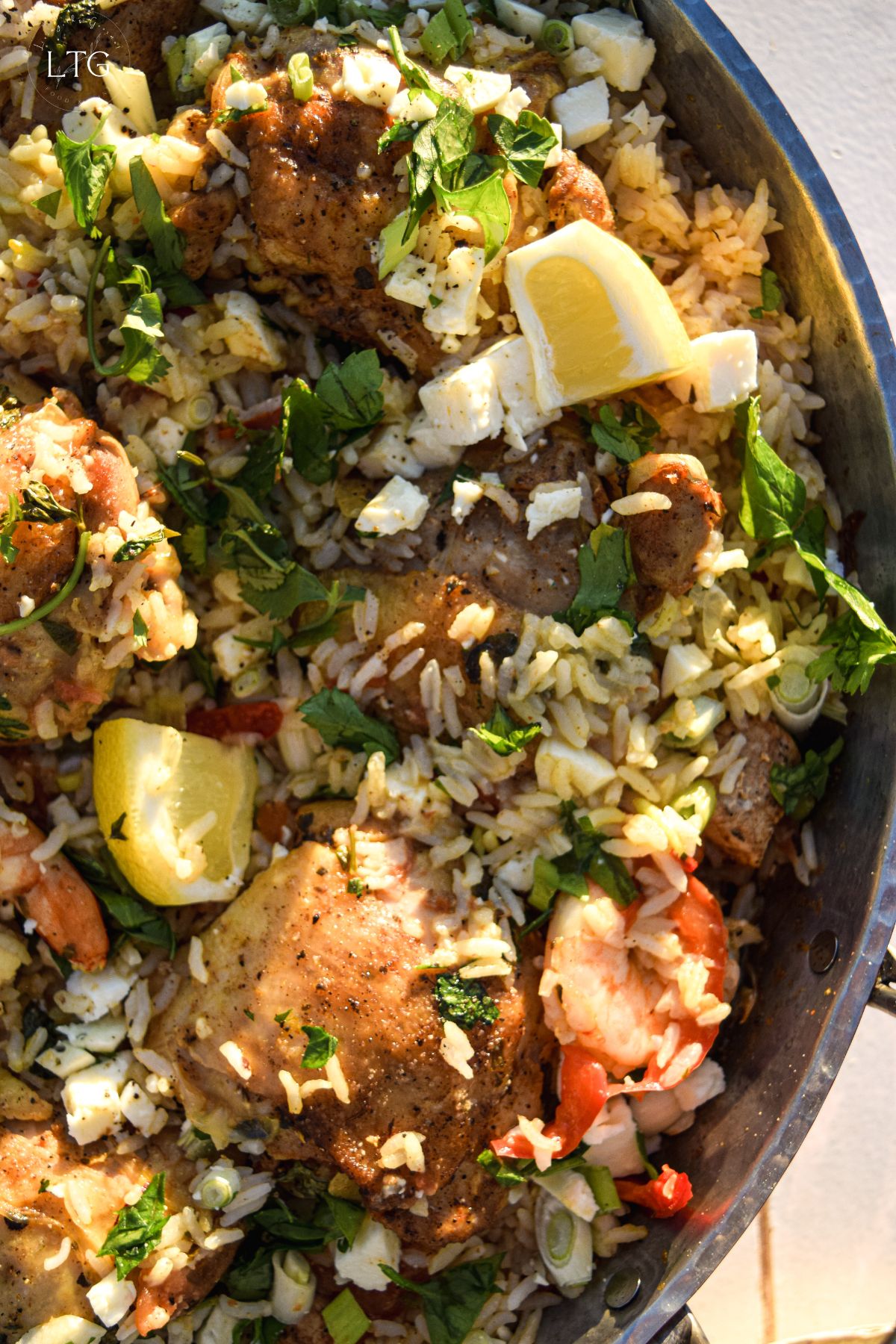
Ingredients for Valencian Paella
For this paella Valenciana recipe, we're using cubed pork, shrimp, and white rice to bring together a great paella.
Meat & Seafood Base
- 2 lbs. boneless pork end, cubed
- Tip: Pork shoulder or country-style ribs also work well *for tender, flavorful results.
- Substitution: Try Spanish chorizo for a smokier, spicier flavor.
- 5-6 bone-in, skin-on chicken thighs
- Tip: Keeping the skin on helps develop a rich flavor when seared.
- Tip 2: If making a purely chicken paella, use a mix of bone-in thighs and chicken strips for texture variance, or use a mix of legs, wings, and thighs.
- Substitution: Boneless thighs or drumsticks can be used, but may cook slightly faster.
- 10-12 extra-large raw shrimp, cleaned
- Tip: I suggest leaving the tails on the shrimp for presentation. Conversely, you can opt to remove them if you prefer for an easier time eating.
- Tip 2: If you're making a wholly seafood paella, I would recommend incorporating either shellfish, such as clams, mussels, or lobster in place of the pork and chicken.
- Substitution: Use peeled deveined medium shrimp or substitute with mussels or scallops.
- 2 cups white rice, cooked as directed
- Note: Your rice of choice will do. Any regular rice can still create an authentic paella Valenciana. There is no 'right' or 'wrong' paella rice.
- Tip: Long-grain or parboiled rice helps maintain texture.
- Leftover Rice: Don't let leftover rice go to waste! For tips on reheating, see my guide here.
- Substitution: Arborio rice, risotto rice, and Bomba rice would all be great substitutes. Bomba rice (arroz bomba) is what you'll find in the most traditional paella Valenciana.
- Coloring: Add saffron or turmeric to the cooking water for the rice to bring together a traditional Spanish paella. In my opinion, the more the rice tastes of saffron, the better - but that's just me.
Marinade for the Pork & Chicken
- 1 tsp. salt
- Note: Plain table salt is all you're looking for here.
- Tip: Adjust to taste depending on the broth and cheese used later in the recipe.
- Substitution: Feel free to get fancy with your gourmet salts.
- 2 tsp. dried oregano
- Tip: Crush it lightly between your fingers to release its natural oils for better aromatics.
- 1 tsp. paprika
- Note: For this recipe, I suggest using either sweet or smoked, I wouldn't recommend using a hot paprika. If you want spice in this recipe, I would suggest sourcing that heat from the peppers you use.
- 1 tsp. black pepper
- Note: Fresh ground will give you the best aromatics.
- 2 tbsp. olive oil
- Note: Acts as a carrier for the spices and helps the meat brown nicely, while also adding some fat, which equates to added moisture.
- 2 tbsp. fresh lemon juice
- Note: Adds citrusy brightness, while also tenderizing the meat. And yes, fresh is best.
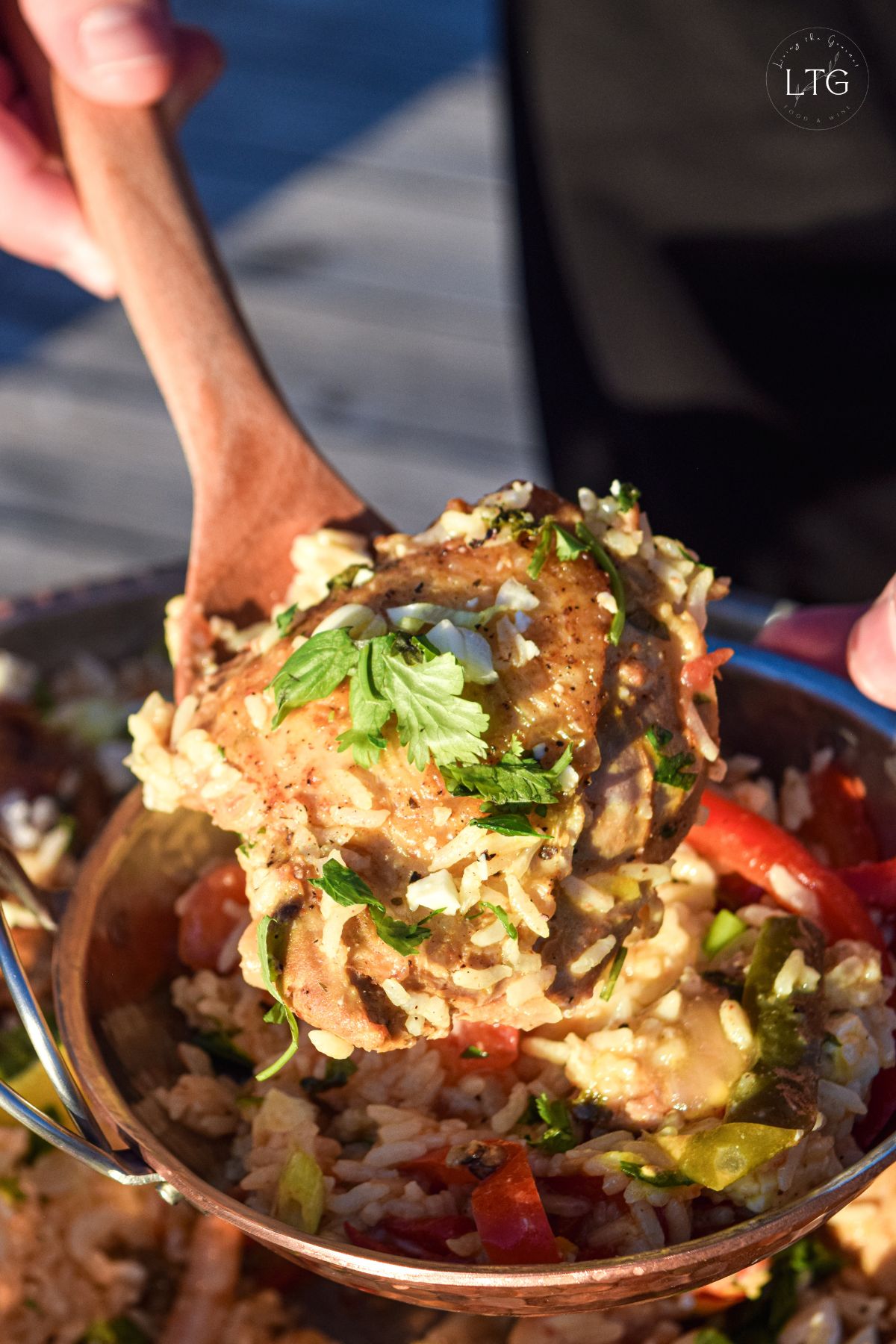
Vegetables & Seasonings
- 2 bell peppers, sliced
- Tip: While I'm only using red bell pepper for this recipe, I would suggest using a mix of green, yellow, and red bell peppers to make the dish as colorful as possible.
- Substitution: Any mix of peppers will work. If you want a spicy paella, mix in your favorite spicy chilis.
- 1 large Vidalia onion, sliced
- Substitution: Any sweet onion will do; avoid sharp white onions.
- 1 whole head of garlic
- Tip: Leave whole for a more mellow flavor. Conversely, squeeze, dice, or grate them for a more evenly distributed garlicy flavor.
- 2 vine-ripened tomatoes, diced
- Tip: I cannot stress enough how important using fresh tomatoes is for this recipe. This recipe simply does not work with canned.
- 2 large jalapeños, sliced (with or without seeds)
- Note: Adjust heat level to taste. While I'm leaving the seeds, feel free to remove the seeds for a milder flavor.
- Substitute: You can replace these either with more bell peppers to reduce heat, or with spicier chilis to increase the heat. It's entirely preference.
- ¼ cup fresh Italian parsley, stems removed
- Note: Use part in the base and part for garnish.
- ¼ cup fresh cilantro, stems removed
- Note: Cilantro Pairs especially well with the lemon and shrimp.
- 1½ cups chicken broth
- Note: Nothing fancy here, you preferred chicken broth will work just fine.
- 1 cup white wine
- Note: I recommend using a dry white wine such as Sauvignon Blanc or Pinot Grigio.
- 2 tbsp. fresh lemon juice
- Note: Adds citrus and brightness. Don't skip it!
- 2 bay leaves
- Note: For added savory depth, just remember to remove it before serving. No one wants to bite down on a leathery bay leaf.
- 1 tsp. saffron
- Note: A key ingredient for the paella's flavor profile, adds earthy, umami depth.
- Substitution: Turmeric can be used for color, though the flavor will differ.
Garnish
- 1 bunch scallions, chopped
- Note: For freshness and color.
- ¼ cup fresh cilantro, stems removed
- Substitute: Swap for more parsley if you prefer less herbaceous flavor.
- ¼ cup fresh Italian parsley, stems removed
- Note: A clean-tasting, peppery finishing herb.
- 8 oz. feta cheese, crumbled
- Note: My own creative add in. It brings some creamy, briny contrast to the dish, while also adding richness.
- 1 lemon, cut into wedges
- Tip: As shown in the pictures, slice up some lemon wedges, and toss them into the pan.
- Tip 2: Finish the dish with a final squeeze before serving. The added acidity and citrus helps tie the dish together nicely.
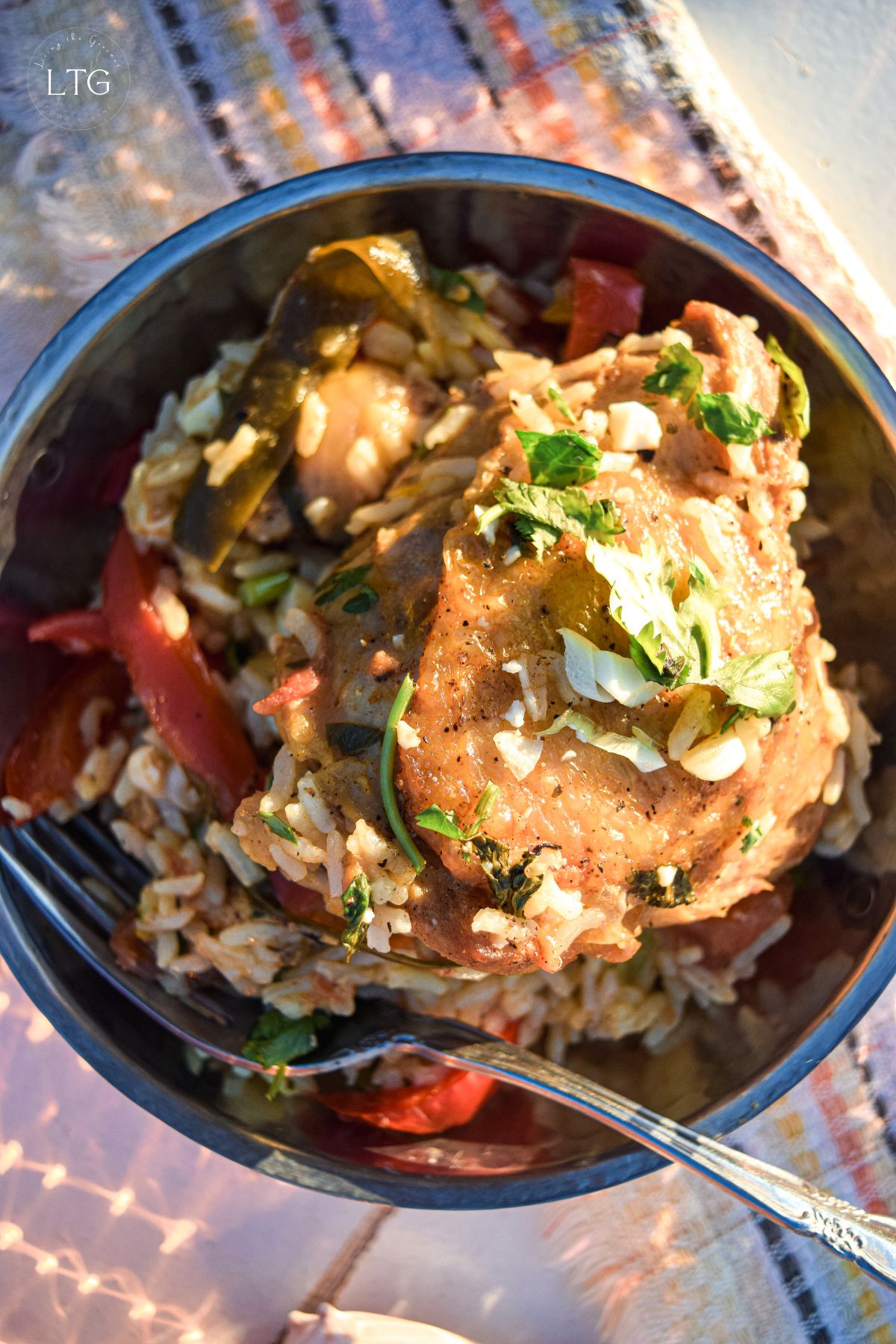
Tips for Preparing This Recipe
Crafting a good paella Valenciana recipe takes attention to detail and patience. However, the tips below will help you achieve the best flavor, texture, and presentation.
- Use the Right Pan
- The reality is that a traditional paella Valenciana recipe is best made in large pans, ideally a specialized 15-inch paella pan. Why? Because this ensures even cooking, and even cooking means a moist, juicy paella. Basically, you want to let everything simmer in a thin layer over the surface of the pan. And this is where copper comes in. Copper ensures that the pan heats up evenly, avoiding 'hot spots' along the pan. Again, even cooking. This is all essentially for developing the coveted socarrat (crispy bottom layer).
- Even Heat Distribution
- Searing: And in case I didn't make it clear above, we need even heat for even cooking - especially when searing the meat. The easiest way to achieve that is by using a copper pan over medium-high heat, which allows the meat to lock in flavor and develop an enviable crust.
- Simmer: Once we've added the liquid to the pan, reduce the flame to medium heat, allowing the rice and broth to simmer gently without scorching the bottom of the pan.
- Layer the Ingredients
- Center Outward: We start things off by placing the heavier, heartier ingredients in the center of the pan. That means things like the chicken and pork get placed directly in the center of the pan to absorb the most heat.
- Outer Layer: After that, we ring the center layer in vegetables and seafood, adding these ingredients along the outer edges of the paella pan, where they'll cook more gently without overcooking. Again, notice how all of these tips relate in one way or another to even cooking?
- Use a Wooden Spoon
- When sautéing and mixing ingredients, a wooden spoon is your best tool. It won't scratch the pan, and it helps gently lift ingredients from the bottom of the pan without disrupting the developing crust.
- Don't Rush the Simmer
- Slow Down: Once you add the chicken stock and wine, let the mixture simmer slowly. Resist the urge to stir too much. This helps the rice absorb the liquid evenly and contributes to that classic paella texture.
- The Final Stir
- Stir and Forget: The final stir does in fact matter. Perform one final stir of the rice before letting the paella rest untouched. Yes, untouched. Do not disturb the paella as it rests. Why? This redistributes all ingredients evenly before the last simmer stage and helps create that perfect paella consistency.
- Let It Rest
- Rest It: After cooking, remove the pan from heat and cover loosely with foil or a clean towel. Let it rest for 5-10 minutes. This step allows the flavors to settle and the rice to firm up.
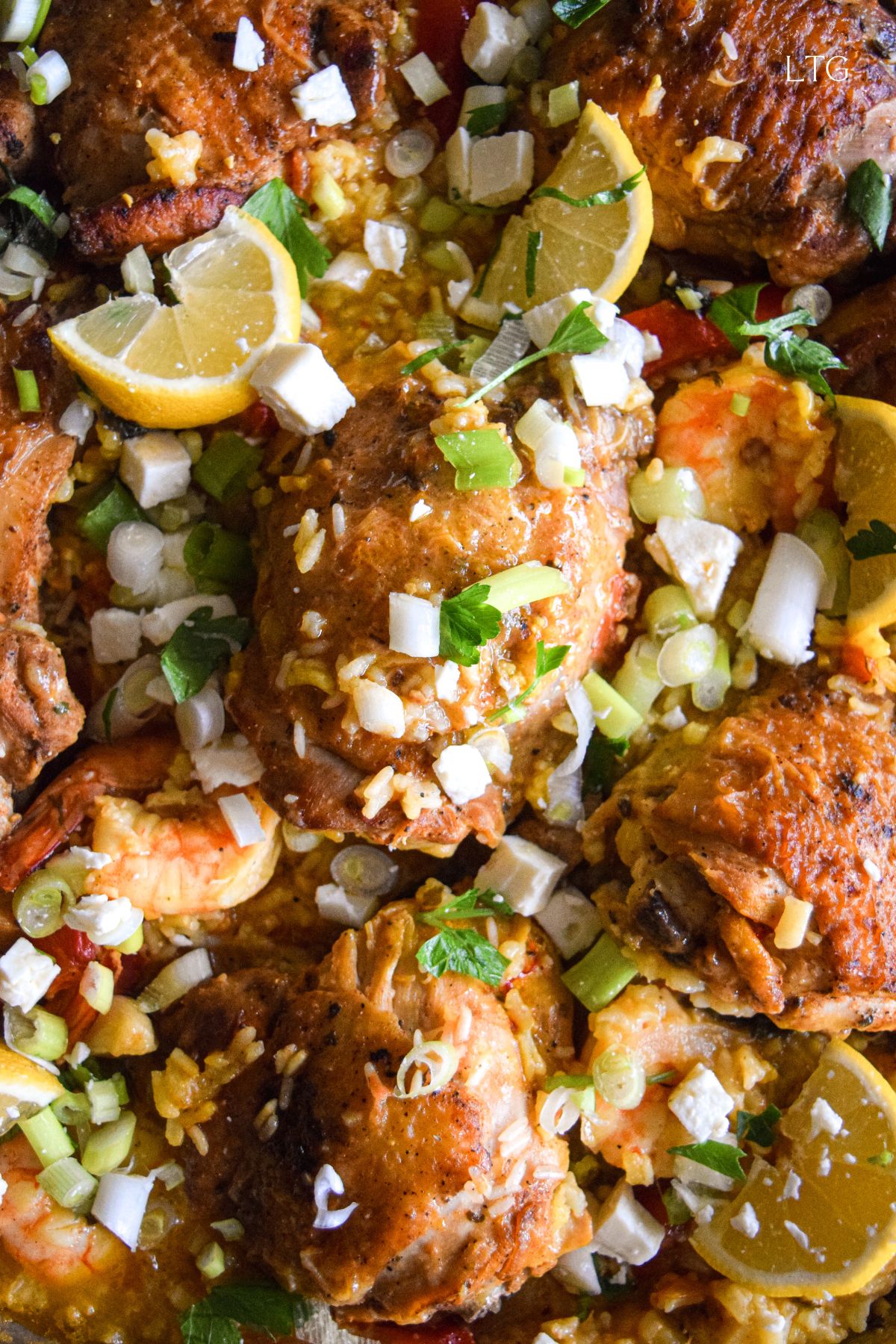

Paella Valenciana
- Total Time: 1 hour 15 minutes
- Yield: 4-6 1x
Ingredients
Meat & Seafood Base:
- 2 lbs. boneless pork end, cubed
- 5-6 bone-in with skin chicken thighs
- 10-12 extra-large raw cleaned shrimp
- 2 cups white rice, cooked as directed
Marinade for the Pork and Chicken Thighs:
- 1 tsp. salt
- 2 tsps. dried oregano
- 1 tsp. paprika
- 1 tsp. black pepper
- 2 tbs. olive oil
- 2 tbs. fresh lemon juice
Vegetables & Seasonings:
- 2 bell peppers, sliced
- 1 large Vidalia onion, sliced
- 1 head of garlic (left whole)
- 2 vine-ripened tomatoes, diced
- 2 large jalapenos (with or without seeds), sliced
- 1/4 cup of fresh Italian parsley, stems removed
- 1/4 cup of fresh cilantro, stems removed
- 1 1/2 cups chicken broth
- 1 cup white wine
- 2 tbs. fresh lemon juice
- 2 bay leaves
- 1 tsp. saffron
Garnish:
- 1 bunch of scallions, chopped
- 1/4 cup of fresh cilantro, stems removed
- 1/4 cup of fresh Italian parsley, stems removed
- 8 oz. feta cheese, crumbled
- 1 lemon, cut into wedges
Instructions
- In a small bowl combine all of the ingredients for the marinade and rub the chicken thighs with the marinade; cover and refrigerate for at least one hour.
- Combine the ingredients for the marinade again and rub it on the cubed pork and refrigerate for at least one hour.
- Heat the pallela pan with 2 tbs. of olive oil.
- Add the chicken thighs and allow the thighs to get a nice golden color on each side.
- Add the onion and garlic and allow the onion to cook down.
- Add the pork and allow the pork to get a nice golden color.
- Add the diced tomatoes and allow them to cook down.
- Add the peppers and again allow the peppers to soften on a low, gentle heat.
- Add the chicken broth and the bay leaves continue to simmer on low, gentle heat for 25 - 30 minutes or so.
- Add a mixture of fresh cilantro and fresh Italian parsley.
- Add the wine and continue to cook on a low, gentle heat.
- Add the shrimp and cook on a low, gentle heat until the shrimp are a nice opaque color.
- Add the saffron.
- Continue to cook down over a low heat, gentle heat for 25 - 30 minutes.
- Taste for seasoning. You may mix together the seasoning for the marinade and add this to the pallela for an extra burst of flavor, cut the salt in half, if you do.
- Prepare the rice as directed. You may either add the saffron or turmeric to the rice water while the rice cooks to give it a golden color.
- When the rice is finished cooking add it to the Pallela.
- Prepare the garnish and dress the top of the Pallela with the garnish before serving.
- Finish with a squeeze of fresh lemon juice.
Notes
Note to cook: Please have patience cooking this recipe. The cook time depends on the size of both the chicken thighs and the pork. Everything should cook gently and slowly so that the meat does not toughen. The shrimp should go in at the very end and should turn opaque when done. You do not want to overcook shrimp since they will toughen also. It is a recipe that requires patience.
- Prep Time: 15 minutes
- Cook Time: 1 hour
- Category: Main Dish
- Cuisine: Spanish

And that's our Paella Valenciana Recipe. If you enjoyed today's paella, or have any questions or suggestions, be sure to let us know in the comments below, we always love hearing from you!
Happy Cooking!
2
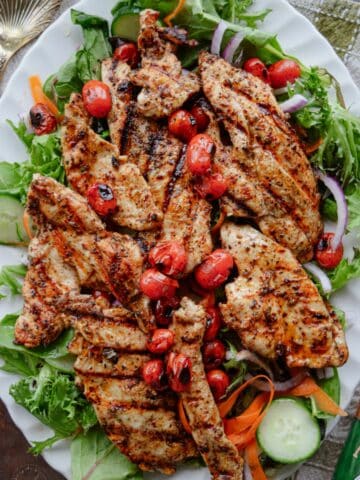


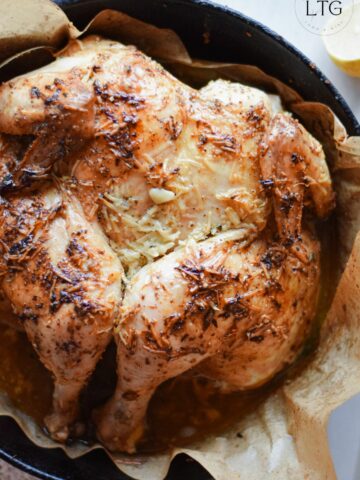
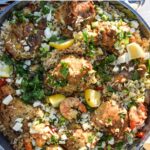

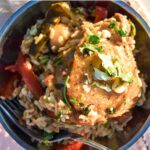

DAVID J MYERS says
Catherine, Just a beautiful dish! I've only had paella once before and it was centered on seafood...another variation I'm guessing. I'm sure that I'd prefer this more traditional version if I left the bell peppers out of the recipe. Take Care, Big Daddy Dave
Catherine Pappas says
I hope you like the recipe if you and Laurie give it a try. I always say to make a recipe your own, so you can always leave out the peppers and substitute what you like in place. My very best to you and Laurie.
Melanie Varey says
I adore paella and make it regularly so will try this recipe-thank you! So colourful and full of lovely flavours.
Catherine Pappas says
thank you for your kind words. I hope that you like the recipe if you give it a try.
Mosaic Designs says
Yes to Paella!!! I loooove it but I never tried to cook it myself, I can't wait to try out your recipe.
Catherine Pappas says
I hope that you enjoy this recipe if you do try it. Thank you for visiting.
Cynthia Nicoletti says
I am always looking for new recipes and love this idea of the shrimp and chicken together !! Will try your recipe.
Catherine Pappas says
I hope that you enjoy this recipe if you do try it. Thank you for visiting.
Jupiter Hadley says
I love a proper Pallela! They are so delicious and filling, while being a one-pan dish.
Catherine Pappas says
I like a one pan dish too. Thank you for visiting.
Garf says
I would love this for my lunch. This looks so good. Thanks for sharing the recipe.
Catherine Pappas says
I wish I could share. Thank you for visiting and your kind words.
Bernice says
You have me drooling over here. It has been far too long since I've had a paella! And I've never had one with chicken. The best is when it's in a giant pan and cooked outside in the streets. So good just like traveling with your tastebuds.
Catherine Pappas says
Thank you for your kind words Bernice. I love traveling in my mind with food!! It takes me everywhere.
Marta says
Great recipe! Great job writing and documenting the recipe. And, the copper pots are gorgeous. We will be trying it soon!
Catherine Pappas says
Thank you for your kind words Marta.
Amanda Dixon says
This paella was fabulous! The saffron added the perfect gourmet touch to really make this dish something special.
Jacqueline Debono says
I've had paella many times in Spain and cooked by friends but have always found it intimidating to make myself. Yours actually looks quite easy and doable. I think it would be a great Sunday lunch dish so am going to give it a go next weekend!
Veronika says
This is such a beautiful dish! I can imagine making it for a big crowd or a Summer cookout party! Cannot wait to try it!
Tristin says
Gorgeous presentation! Your pictures alone, with the reflective glints of light from the copper, is enough to make me want to run out and buy all copper cookware. I have always wanted to try my hand at making paella and will definitely follow your advice on the addition of the saffron!!
AISilva says
Paella brings back memories of Spain for me. I've never thought to make it myself though, so I'm so glad to make this myself. I love the combination of chicken and shrimp as well. Thanks!
Elaine says
I make a paella like this every time my friends come over. There is just something magical about it, and I can't wait to try your recipe!